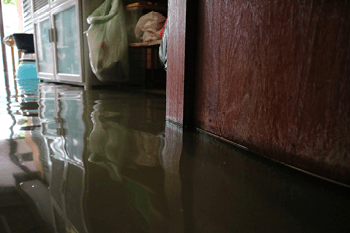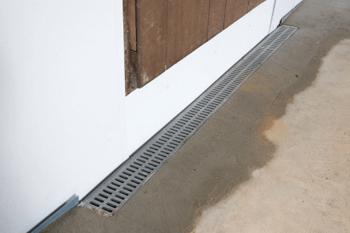What Is Basement Waterproofing?

Basement Waterproofing is the use of technology, material and products to protect the basement or foundation of a home from the damaging effects of groundwater. Without some form of defense against moisture, a structure could be thoroughly undone over time as groundwater forces its way through porous materials, leaving behind signs of it's persistence, like condensation, efflorescence, and the heavy smell of mildew. If left unattended, the damage could be devastating, and cost egregious amounts to fix--even worse, water leads to mold and mildew, which can cause potentially fatal health issues.
Dangers of a wet basement
We may not think about it often--we drink water, bathe in it, cook with it--but it is the single most destructive force on earth. The effects of water on a home can be devastating and even dangerous to your health. Where water sits in a basement or crawlspace:
- Mold and mildew will grow and respiratory issues can arise.
- Pests will flock.
- Furniture and belongings will be damaged.
- Efflorescence may appear.
- Structural support will be undermined.

Depending on location, soil conditions and climate, each home will have different needs. In the south, the soil tends to be dense and claylike. In these conditions, the soil can expand with the presence of water, causing stress against the building materials and working its way through the porous concrete and stone that most foundations are made of. The effect can be even more devastating on wooden frames, sill plates, and support beams, as wood is much more vulnerable to the effects of water. Places with differing soil make ups will have slightly different issues, but the effect is still the same: The water bores away at, cracks, and seeps through building materials, into the home where it can wreak havoc.
Types of basement waterproofing
There are really only two ways of dealing with water in a home. The first, to block groundwater from entering the space. This can be done with protective coatings, or drainage trenches buried around the perimeter of the foundation. The other, to control and direct the water out of the home, before it can do any lasting damage. These methods are perhaps most commonly referred to as, Exterior and Interior basement waterproofing.
Both options work, and well--but one may work better for you and your home than another. With water control, you don't have to worry about water when you do see it--it will be pumped out, sucked up and dealt with by the system. If you see water after the home has been waterproofed, it could point to a flaw in the exterior system, which can be costly to repair.
Exterior Waterproofing:
Exterior basement waterproofing in the traditional sense requires excavation and disruption of the home, which in and of itself could be a risk. Maneuvering heavy duty excavation equipment around the foundation is intricate work, and if something goes wrong, the entire structure could be compromised. If an exterior system does fail, it's the same process to fix it. The foundation will have to be dug out again and treated.
Interior Waterproofing:
With interior systems, there's significantly less risk to the home, but the systems will need to be cared for and inspected regularly to stay one step ahead of the water.
A sump pump, dehumidifier or even a moisture barrier will only work effectively if they are properly taken care of. This is important for many reasons--the largest being health and safety concerns. Other reasons may be as simple as home value.
It's harder to sell a home with a wet basement or crawlspace than a home with a dry basement or crawlspace. Prospective buyers are likely to get to the damp space and see nothing but dollar signs. A wet basement or crawl space also significantly limits space within the home, which can be a major turn off to buyers, and also cause homeowners grief in smaller homes.
With all this in mind, it's vital that if you've seen signs of water intrusion in your home's basement or crawlspace, that you reach out to a professional as soon as possible.
With a professional company, you can be assured that you and your home are in good hands. After all, the industry has been around for a long time.
The history of basement waterproofing

Water has been an issue for human settlements and dwellings for just as long as it has been a blessing to our survival. Since we made the transition from nomadic hunting tribes to agricultural settlements, we have been battling against the effects of water in our homes. When we made this switch, our dwellings needed space to store food and fuel, such as wood and coal to get us through harsh winters--and groundwater became an enduring problem.
The first use of rudimentary waterproofing techniques, such as bitumen, a crude form of natural oil that can be pumped from the ground, can be traced back to Biblical times. The viscous material was used to coat the outsides of bricks and building materials around the foundation, so that grain, salted meat, coal and wood could be stored below the home, without the fear of premature rot caused by groundwater. Techniques would stay the same for hundreds of years, using the earth's natural resources, like bitumen to block out water, and rushes, or straw, to soak up what managed to get through.
It wasn't until the mid to late 1800s that basement waterproofing methods began to advance, the dangers of groundwater had been fully realized, with its power to decimate a home slowly, by eroding away the structural support. Around this time, the industrial revolution was coming into full swing, but many Americans still relied upon farming and agriculture to make their livings. During this time, drainage became a priority among homeowners with cellars and basements, which many homes across the country had. In the late 1830s, a New York farmer named John Johnston came up with Drain Tile, a drainage system that allows water to be funneled out and away from the home, similar to a French drain--also invented around this time, by another American farmer, Henry French.
In the 80s and 90s the industry began shifting from Mom & Pop businesses to more structured contracting companies. Around this time many of the giants in the business emerged, putting their own stamps on the age old practice. Nowadays, there's far more you can do to waterproof your home than just drain tile, bitumen or french drains. Full water control and waterproofing systems exist on the market today, able to be customized to any environment, and any one home.
Over the past 30 years, many advancements and improvements have been made in the basement waterproofing industry, making the process more efficient and effective in the long run. With innovations such as dehumidifiers, sump pumps, and moisture barriers, along with countless other products available to homeowners today--water is no longer an unstoppable force.
If you're in need of a basement waterproofing consultation, the experts here at HomePro Match are just a click away!



